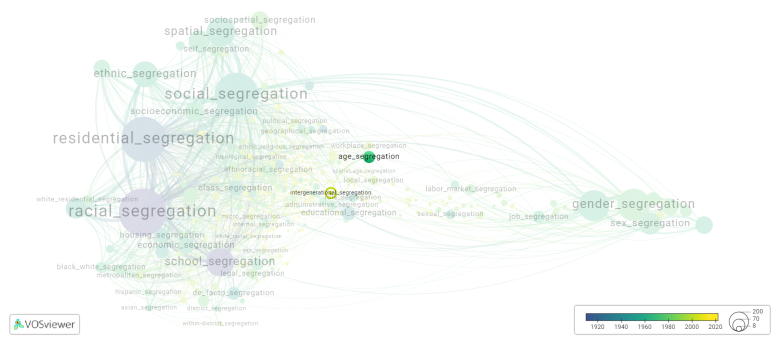Intergenerational segregation: Difference between revisions
(Creating page) |
(Creating page) |
||
| Line 16: | Line 16: | ||
[[File:intergenerational_segregation.png|780x780px]] | [[File:intergenerational_segregation.png|780x780px]] | ||
Visualization based on the [[How_to_cite_Segregation_Wiki| research]] | |||
For the complete network of associated segregation forms, see: | For the complete network of associated segregation forms, see: | ||
year of publication https://tinyurl.com/2235lkhw | * First year of publication https://tinyurl.com/2235lkhw | ||
Louvain clusters https://tinyurl.com/2d8wg5n3 | * Louvain clusters https://tinyurl.com/2d8wg5n3 | ||
* Betweenness centrality https://tinyurl.com/223udk5r | |||
* Disciplines where segregation forms first appeared https://tinyurl.com/244d8unz | |||
==References== | ==References== | ||
==Notes== | ==Notes== | ||
Revision as of 13:40, 3 October 2024
Date and country of first publication[1]
2011
United States
Definition
Intergenerational segregation refers to a social phenomenon where different age groups, such as children, young adults, middle-aged adults, and elderly individuals, are physically separated from one another and do not interact within the same spaces or communities. This segregation can occur in various settings such as schools, neighborhoods, workplaces, and social events.
Intergenerational segregation can have negative consequences on individuals and society as a whole. It can lead to misunderstandings and stereotypes between different age groups, hinder social cohesion and support systems, and contribute to ageism and discrimination. It can also limit opportunities for intergenerational learning and collaboration.
Efforts to promote intergenerational integration and interaction can help bridge the gap between different age groups and foster understanding and respect among individuals of all ages. This can be achieved through intergenerational programs, community events, and initiatives that bring people of different generations together to learn from one another and build connections.
See also
Related segregation forms
Intergenerational segregation is frequently discussed in the literature with the following segregation forms:
Visualization based on the research
For the complete network of associated segregation forms, see:
- First year of publication https://tinyurl.com/2235lkhw
- Louvain clusters https://tinyurl.com/2d8wg5n3
- Betweenness centrality https://tinyurl.com/223udk5r
- Disciplines where segregation forms first appeared https://tinyurl.com/244d8unz
References
Notes
- ↑ Date and country of first publication as informed by the Scopus database (December 2023).
At its current state, this definition has been generated by a Large Language Model (LLM) so far without review by an independent researcher or a member of the curating team of segregation experts that keep the Segregation Wiki online. While we strive for accuracy, we cannot guarantee its reliability, completeness and timeliness. Please use this content with caution and verify information as needed. Also, feel free to improve on the definition as you see fit, including the use of references and other informational resources. We value your input in enhancing the quality and accuracy of the definitions of segregation forms collectively offered in the Segregation Wiki ©.
Intergenerational segregation appears in the following literature
Kral M.J., Idlout L., Minore J.B., Dyck R.J., Kirmayer L.J. (2011). Unikkaartuit: Meanings of Well Being, Unhappiness, Health, and Community Change Among Inuit in Nunavut, Canada. American Journal of Community Psychology, 48(3-4), 426-438. https://doi.org/10.1007/s10464-011-9431-4
Liu C. (2017). Family based food practices and their intergenerational geographies in contemporary Guangzhou, China. Transactions of the Institute of British Geographers, 42(4), 572-583. Blackwell Publishing Ltd.https://doi.org/10.1111/tran.12178
Lai A., Burchett R. (2021). Involving Retired Citizens in ESL Education: Case Study of a Secondary School Program. Journal of Intergenerational Relationships, 19(2), 249-271. Routledge.https://doi.org/10.1080/15350770.2020.1739588
Das Gupta D., Wong D.W.S. (2022). Changing Age Segregation in the US: 1990 to 2010. Research on Aging, 44(9-10), 669-681. SAGE Publications Inc..https://doi.org/10.1177/01640275221074398

